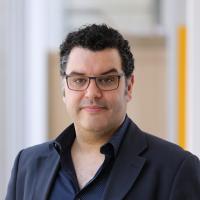Professor of Neuroscience and Neurology; Former Director and Chief Executive Officer of Columbia's Zuckerman Institute (2017–2022)
From the moment we are born until we die, our brain is going. It’s not waiting to respond to stimuli; it’s generating stuff.
Rui Costa studies the brain mechanisms that guide behavior — both innate and learned. Specifically, he examines the brain circuitry that underlies spontaneous movement, and compares it to the circuitry involved in movement that has been learned over time. He hopes to apply this understanding to finding better ways to treat disorders of movement, such as Parkinson's disease.
Read more about Rui Costa, DVM, PhD >
Playing tennis is not an inborn skill. There is no innate stimulus-response wiring in the brain for a killer backhand. And yet humans learn to master the sport, and so many other new types of movement, over both short and long time spans. Rui Costa, PhD, director and chief executive officer at Columbia’s Mortimer B. Zuckerman Mind Brain Behavior Institute, wants to know how we build up such a stunning repertoire of behavior and continue to expand upon it throughout our lives.
He asks questions that on the surface seem simple, but, upon further inspection, are extraordinarily complex. How do we initiate movement? How do we select which movements led to the outcome we wanted so we can repeat them? How do we refine those movements? And, coming full circle, how do we break those patterns to learn new ones?
The basal ganglia, a collection of structures near the center of the brain, is a focal point of Dr. Costa’s research; in part, because it is tied to so many disorders that involve a disruption of behavior. “If you look at what goes wrong,” Dr. Costa says, “this is an amazingly prominent area — from autism to Tourette’s, impulsivity, compulsivity, Parkinson’s, Huntington’s; from movement disorders to psychiatric disorders to developmental disorders, even schizophrenia.”
His lab uses several methods. By mapping electrical signals in the brains of awake, behaving laboratory mice, for example, they can monitor how brain cells guide an animal’s spontaneous movements (called “babbling”), as it learns specific actions to obtain rewards or as these actions become habits. Dr. Costa’s lab has located parallel circuits in basal ganglia and the cortex — the outer and most advanced layer of the brain — that control habits and intentional movements, respectively, and found that they inhibit each other, which explains why habits are so hard to break. With optogenetics — a technique that uses light to switch cells on and on — they can determine whether those cells are necessary for certain abilities. And using brain-machine interfaces in which a mouse learns to alter an auditory tone by activating certain brain cells, they can see if the same circuits also contribute to more abstract skills.
Open questions include whether we are born with established modules for movement that we recombine in various ways, if there is a center in the brain that provides the variability needed to try new things, and how the brain learns which aspect of a movement — flexing of the hand versus the elbow, say — got us what we wanted.
Understanding these circuits could enable new therapies for Parkinson’s disease or other disorders of movement. Brain- machine interfaces could also enable paralyzed people to operate a computer. In addition, they could help others learn to control their own brain activity using neurofeedback, a technique in which one’s brain activity is translated into an auditory or visual signal that can be used to monitor the performance of one’s own brain circuits.
Dr. Costa sees action as the purpose of the brain and mind. We are always trying new things — babbling — whether in action or thought, and shaping behavior based on the consequences. “From the moment we are born until we die, our brain is going,” he says. “It’s not waiting to respond to stimuli, it’s generating stuff. We have an acting brain, an acting nervous system, and that’s why I want to study it.”
Member (2019)
Principal Investigator (2017-present)
Early Career Scientist Award (2012-2017)
Ariëns Kappers Award (2017)
GQ Men of the Year - Science (2015)
Young Investigator Career Award (2014)
Knighted Commander (2014)
Elected Member (2014)
Young Investigator Award (2012)
Young Investigator Award (2001)
Tecuapetla F, Jin X, Lima SQ,
Cell.2016 Jul 28
Gremel CM, Chancey JH, Atwood BK, Luo G, Neve R, Ramakrishnan C, Deisseroth K, Lovinger DM,
Neuron.2016 Jun 15
Jin X, Tecuapetla F,
Nat Neurosci.2014 Mar
Cui G, Jun SB, Jin X, Pham MD, Vogel SS, Lovinger DM,
Nature.2013 Feb 14
Koralek AC, Jin X, Long JD 2nd, , Carmena JM
Nature.2012 Mar 4